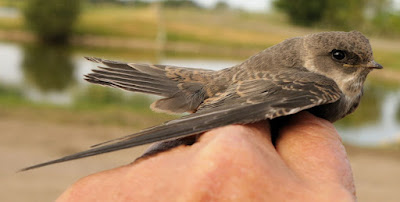I missed a few visits in May due to a holiday in Greece but prior to that, early April had been my last visit to Oakenclough when we caught 15 birds – 6 Lesser Redpoll, 2 Goldfinch, 2 Coal Tit, 1 Dunnock, 1 Reed Bunting, 1 Chaffinch, 1 Great Tit, 1 Siskin.
Andy and Will filled in the gaps of May and now it was my turn to see how the breeding season was shaping, more so following the exceptionally dry and hot month of June. Would there be juveniles of the year, adults in moult or even the beginning of post-juvenile dispersal to bring new birds on the block? Time would tell.
And talking of time, a five o’clock alarm followed by a meet with Andy at six hours past midnight seemed an ungodly hour for those of us accustomed to leisurely days on a Greek beach or breakfast in a sunny Stalmine garden.
A slow start didn’t really pick up speed. We finished at 1100 with 20 new birds of 11 species and an interesting mix of 3 Robin, 2 Garden Warbler, 2 Siskin, 2 Goldcrest, 2 Willow Warbler, 2 Blue Tit, 2 Coal Tit, 2 Long-tailed Tit, 1 Song Thrush, 1 Chiffchaff, 1 Oystercatcher.
The Robins caught were all fresh, rusty speckled juveniles. Even at this young age Robins display the hostility so typical of adult birds that puff out their red chests when presented with a rival. In this case it is the reflection of another Robin that the young ones see in the camera lens, or pointed aggression directed at the person taking the photograph.
Four or five Garden Warblers could be heard in song this morning. And then later in the morning we caught two female Garden Warblers, both with well developed brood patches. We caught no males or recently fledged young suggesting that we need to revisit the site soon.
Two Siskins were caught at the same time, an adult male together with a recently fledged juvenile. We released the two jointly and they flew off in the same direction.
Siskin
Siskin
Just one Willow Warbler was something of a disappointment when three or four were in song throughout the area and that by late June there should be good numbers of juveniles around. We didn’t know of a Chiffchaff on site until we caught it.
Willow Warbler
Chiffchaff
A juvenile Song Thrush was a welcome addition to the mix when we catch so few nowadays.
Song Thrush
After his success in landing three Avocets this week, Andy was at it again in the shape of a young Oystercatcher along the bank of the close by reservoir. While one chick legged it into the distance its sibling ran the “wrong” way and ended up in Andy’s net. Wader ringing totals this year – Avocet 3, Oystercatcher 1, Lapwing 0. There’s something seriously amiss in those figures for North West England when Lapwings should be winning by country miles.
Log in soon for more news and views soon from Another Bird Blog.
Linking this weekend to Eileen's Blogspot.





































































